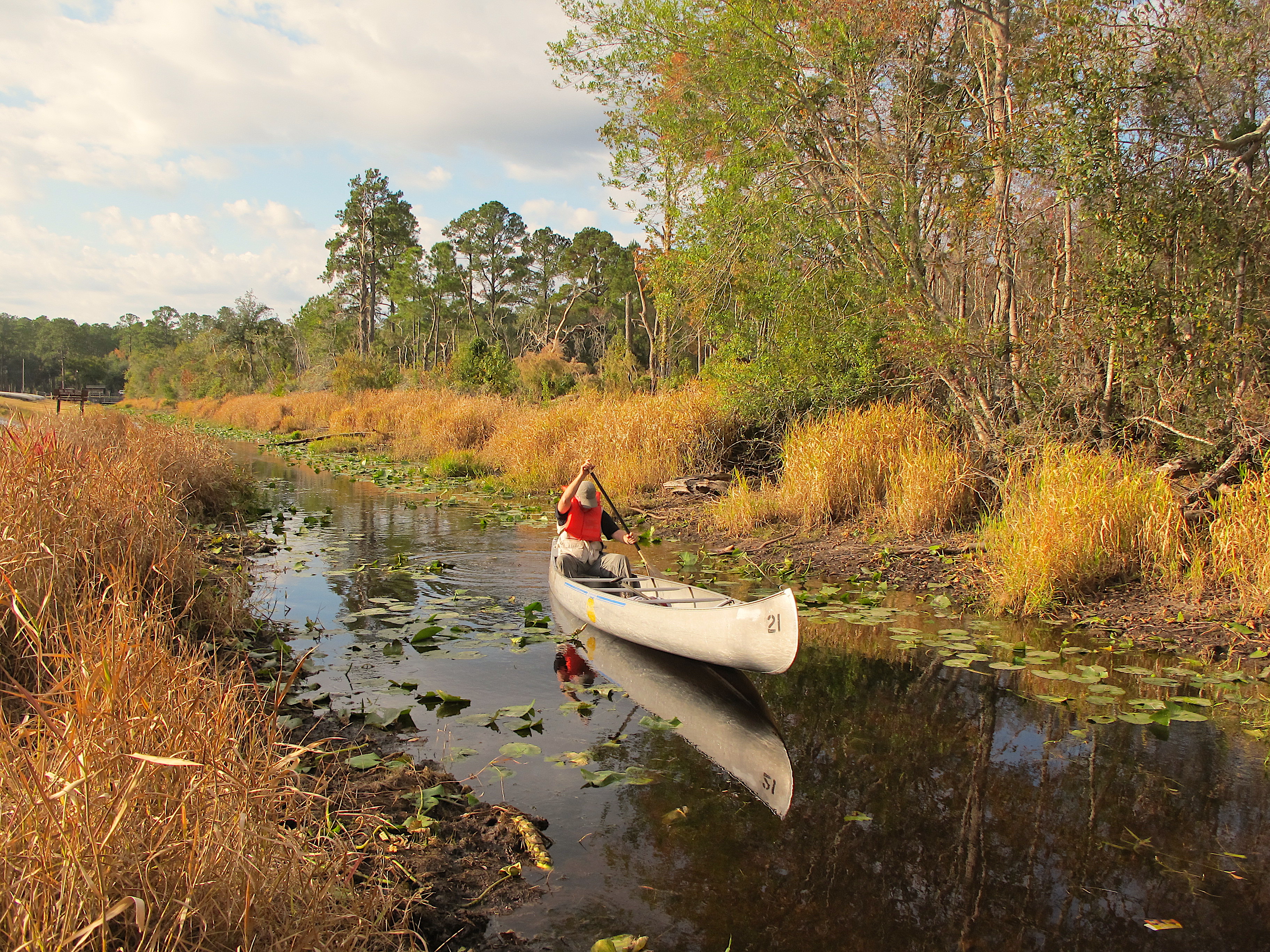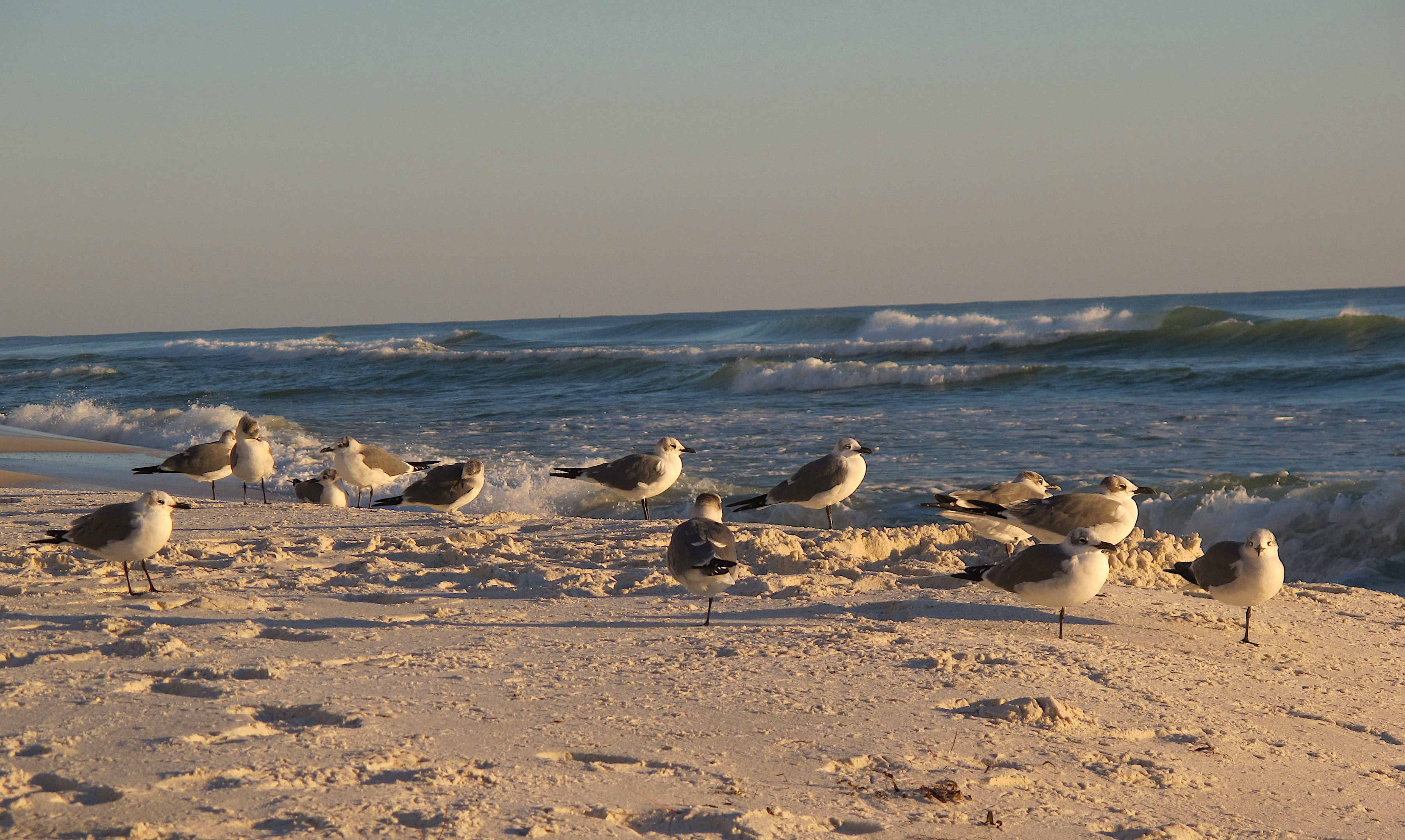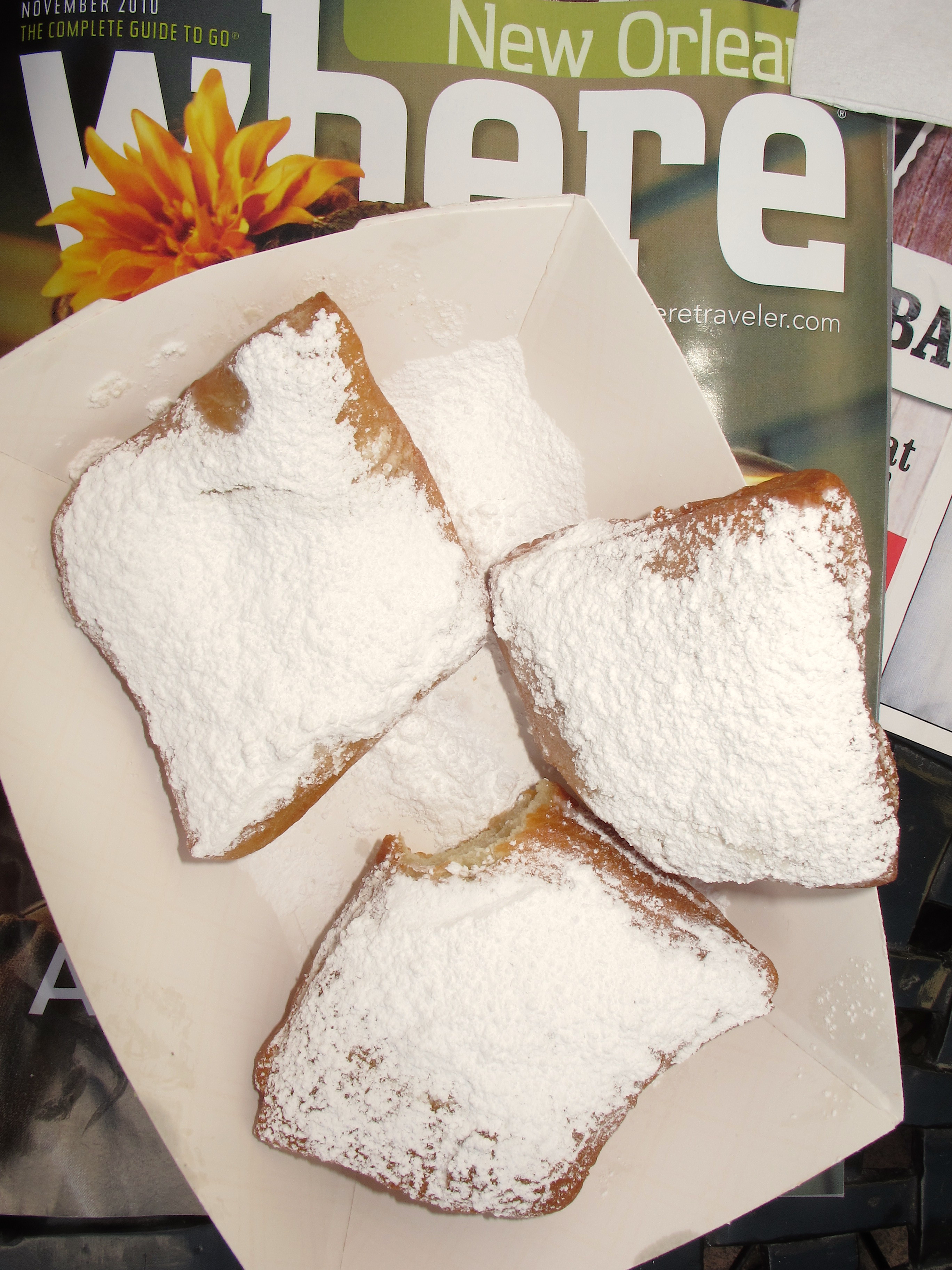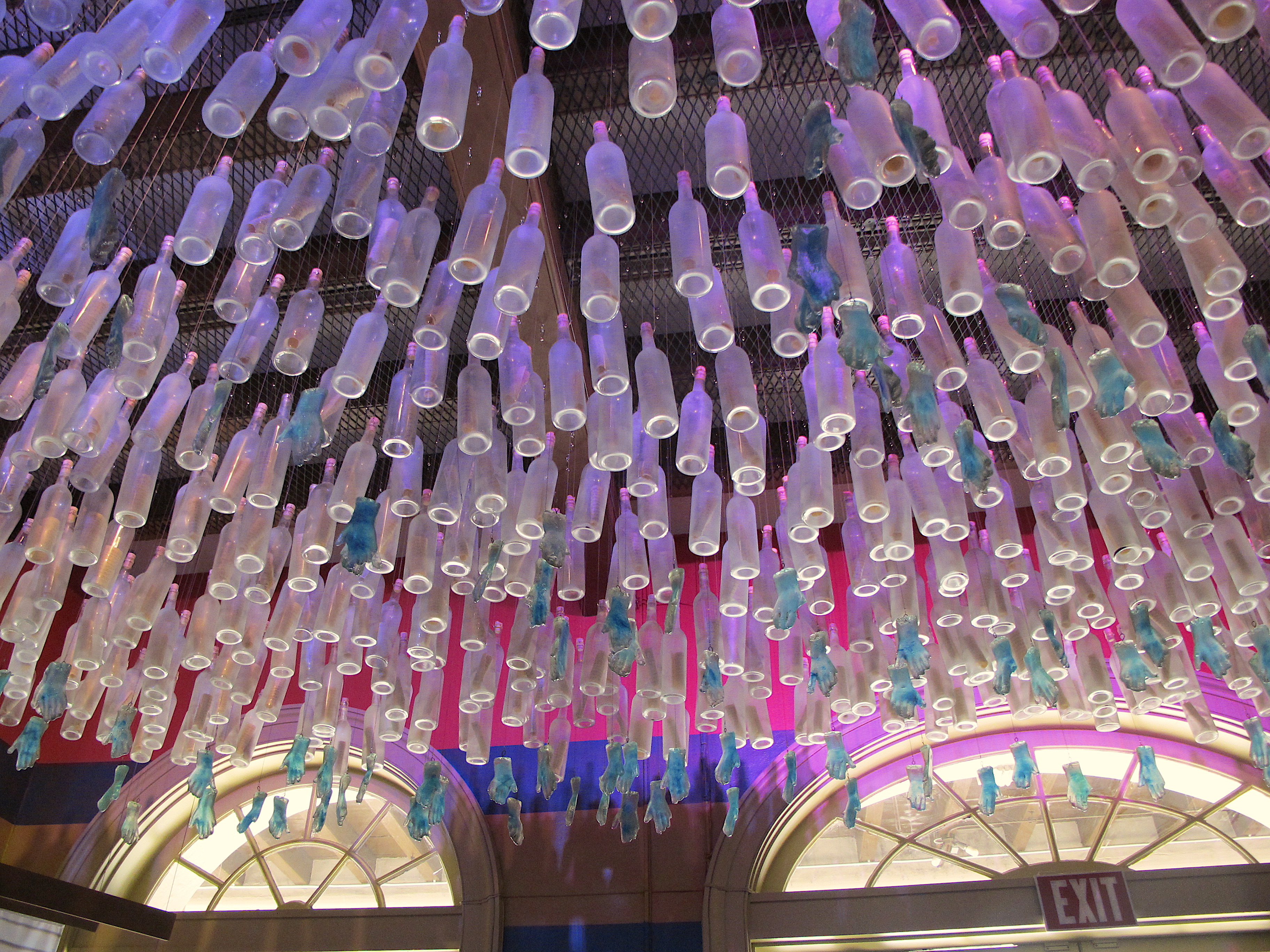I wanted to canoe in a swamp so we headed off to Okefenokee National Wild Life Refuge in Georgia. On our arrival, the park wardens told us that the water levels were low but we could push, pull and pole the canoe down the channel and into the lake. We decided Tom should push, pull and pole the canoe and I would video (ok, so I decided Tom would push and pull the canoe and I would video). Unfortunately, I missed him plunging knee deep into the black swampy alligator infested channel. I asked him to do that again for the camera, his look was as black as the swamp. Sometimes he has no sense of humour.
Enlarge

Adventurouspirits
Finally, he told me to “get in” as he needed the canoe to have equal weight distribution in the front and the back, hey wait a minute he is about 80lbs heavier than me. He insisted that, having me in the front would help him pole the canoe through the watery marsh so being as obliging as am I sometimes, I clambered into the canoe. We poled, we paddled finally we were at the entrance to the lake.
Enlarge

Adventurouspirits
WHOA!! A large alligator nearly collides with the canoe and I am in front (dinner for the alligator?) Now it is Tom’s turn to be laughing at me.
“What don’t tell me you’re becoming timid, and that you are afraid of an alligator next to you” he said. I was not amused.
We headed out to the centre of the marshy lake and I counted eight alligators eyeing me in the water. I wanted to know if alligators are as aggressive as African crocodiles, Tom says no. What on earth, does he know about alligators? Suddenly he is now an expert on alligators and crocodiles. After 30 minutes of canoeing around the alligators, I had had enough. I was not sure if alligators do eat people as a crocodile does.
Enlarge

Adventurouspirits
“We are heading back,” I demanded. Tom suddenly lost his hearing and continued paddling down the lake. Ok so I am going to have to get ugly. I reminded him of the time he demanded that we go back when we were lost in the dark in the shantytowns of Dar Es Salem, Tanzania. There is nothing worse than having a domestic dispute in a canoe in a lake surrounded by gators or lost at night in a seedy part of an unfamiliar city.
I won and we headed back pulling and pushing our way down the 2 inches deep marshy channel. We camped that night at Okefenokee and the next morning we headed towards Florida.
We arrived at the little town of Apalachicola on the Florida coast. It has 7,000 acres of oyster beds producing 10% of national supply and 90% of state requirements. It was time for us to try their oysters.
We entered the little restaurant with a huge pink dusty flamingo hanging from the ceiling. Tom was looking for ambiance and oysters so he asked what I thought of the place. The locals are eating here I replied so it must be ok.
Enlarge

Adventurouspirits
Tom ordered his oysters raw and I ordered mine steamed and topped with parmesan cheese. Tom said his oysters were delicious, very meaty, large, slippery and tasty with a dash of lemon and horseradish. My oyster arrived shrunken and tiny, sprinkled with parmesan cheese. I guess when they steam the oysters they shrink and the reason for the parmesan I think is to add back some flavour. Next time I will stick to nude oysters.
Enlarge

Adventurouspirits
We had hoped to Scuba dive at Panama City, Florida. “We don’t run dives during the week,” we were informed when asking about booking a dive. Apparently, the water is too cold.
“Ah ha and what is the water temperature?” Tom asks.
“65°F” the dive master replied.
Tom nearly choked, “65 that is not cold that is a heat wave in Canada,” he replied. Unfortunately, there were no divers willing to go out and they needed a minimum of four divers to book a boat so we headed for the beach instead and had a margarita drink to drown our disappointed. “We will just have to wait for Baja,” I reassured a very disappointed Tom.
If ever you are on the Emerald coast of North West Florida take a drive along route 30A. I think I found the perfect little piece of heaven if ever I should win the lottery or be able to stay in one place for longer than few weeks. I do eventually plan to settle down, despite what all my family and friends think. (After South America and Asia though).
We stopped at Deer Lake State Park for lunch and went for a walk along a spectacular white beach. It was magnificent and Tom even wanted to stay for a few days but I had to keep moving.
Enlarge

Adventurouspirits
We headed down the coast hugging the coastal roads and taking ferries where necessary passing through Alabama and Mississippi until we reach Louisiana. Today we are off to explore New Orleans.
Enlarge

Adventurouspirits
The video below is taken by me with my Canon G11 and it is very shakiness in some sections because Tom was rocking the canoe.
We were excited and curious about New Orleans, a city famous for its music, Creole, Cajun and Louisiana food, fancy cocktails, entertainers, French Quarters, Voodoo, haunted cemeteries, the Saints and the Natchez ferry traveling along the Mississippi river. We had watched the city being devastated by Hurricane Katrina on TV, we have listened to Louis Armstrong playing jazz on his trumpet, Fats Domino on the piano and there is almost a sense of familiarity with the city of which we had heard so much about but not walked its streets.
Enlarge

Adventurouspirits
Enlarge

Adventurouspirits
Our day started by lining up for Café Du Monde, the original French Market coffee stand which has been serving café au lait or the famous chicory flavoured coffee and hot beignets 24 hours a day all year round since 1862. The beignets are French originated, tasty square sugar dusted fried dough and are designated the unofficial donuts of New Orleans. The line up to get in stretches around the corner and disappears from sight. People wait patiently whilst clowns with balloons entertain restless children and street bands beat out songs to entertain the adults. Once inside we relaxed at a table listened to the street musicians and watched the people go by and planned our day. The beignets were delicious.
Enlarge

Adventurouspirits
“Living with Hurricanes: Katrina and beyond” an exhibition at the Louisiana State Museum was our first place to visit. It details the hurricane Katrina, this historic storm and its tragic aftermath, which occurred on August 29th 2005. A colourful display of bottles with messages in them hang from the ceiling of the entrance into the museum along with piano of Fat Domino which was ruined in the floods. We learnt how the levees failed, how for years the engineers had warned that the levees were inadequate and how the politicians refused to listen. How the incredible destruction and the associated loss of life might have been lessened had those with the money listened to those with the knowledge. The chaos surrounding the vulnerable when the disaster hit, the heroes and heroines who risked their lives to save others. At least 1,836 people lost their lives in the actual hurricane or in the subsequent flooding most of them the elderly. As we spent more and more time in New Orleans, we began to feel that this is the forgotten city of the USA.
Enlarge

Adventurouspirits
Enlarge

Adventurouspirits
Our curiosity of voodooism soon had us walking to St Louis Cemetery Number 1 established 1789. New Orleans’ notoriously high water table necessitates the practice of burying the dead in above ground tombs. Also called the “City of the dead” because when the Mississippi flooded, corpses float down the streets.
Enlarge

Adventurouspirits
We planned to visit the revival tomb reputed to be the burial place of the notorious Marie Laveau the Voodoo Queen. Voodoo is a mystic cult with African origins of ancestor worship and was brought to New Orleans from Santo Domingo and flourished in the 19th century. Marie Laveau was the most widely known of the practitioners on the cult. She was born in1801 famous as a healer and leader of all the voodoos in New Orleans specializing in affaires d’amour and love portions. She presided over public ceremonies at Congo square and secret rituals
Enlarge

Adventurouspirits
Every guidebook or pamphlet we read advised against going to the cemetery alone warning of muggers and pickpocket operators waiting in the secluded areas, never the less we headed off alone with no guide. We arrived at the cemetery to find it full of tour guides followed around by tourists. Not a mugger or pickpocket operator in sight just groups of people with cameras hanging around their necks. We felt quite safe so headed deep into the cemetery. We watched at the gravesite of Marie Laveau as a modern day “voodoo queen” completed a ritual for the tourists. Placing the X sign of voodoo to have wishes granted, offerings are made and placed at the base, Mardi gras beads, alcohol, oranges, cigars and candies lie in the puddles and cameras click away.
Enlarge

Adventurouspirits
Wanting more information, we decided to pay a visit to the Voodoo Museum. Sitting behind his desk was John Martin a Voodoo priest cuddling 2 pythons on his chest. He talked about his “babies” saying they know he is their parent; after we paid our admission fee, we entered the tiny museum. The museum was filled with pictures, photographs, African carvings, masks, stuffed animals and altars to various “gods’ both Catholic and Voodoo. Beneath the altars were offerings made by visitors seeking some wish from their ancestors or God. We had visited voodoo markets in Benin and Togo in West Africa and the voodooism in New Orleans seems to be a million miles away, it has evolved into its own way of being in the world. It was impossible for us to make the connection between African voodoo and New Orleans voodoo they are both unique in their own way.
Enlarge

Adventurouspirits
New Orleans is listed as the second dirtiest city in the USA and as we walked through the French Quarters, we had to agree the city is grubby. Noisy bars, quaint restaurants, porno shops, and cracked broken sidewalks line Bourbon Street. As the day progresses the drunken debauchery increases, it is legal to carry an alcoholic drink in the streets, restaurants and bars refuse the use of their toilets unless you are a customer so the smell of urine permeates the air.
Enlarge

Adventurouspirits
Men on balconies overlooking the street encourage girls to lift their shirts and expose themselves and then the men would toss down Mardi Gras beads as a reward. Musicians beat out a tune in the streets, artists show case their art work along the wrought iron fence surrounding Jackson Square, performers entertain with amazing talents, wedding parties have their photos taken in Jackson Square and a Hare Krishna parade holds up the traffic.
Enlarge

Adventurouspirits
Enlarge

Adventurouspirits
Enlarge

Adventurouspirits
Enlarge

Adventurouspirits
We walk along the Moonwalk, the boardwalk along the Mississippi river and watch as rats scuttle about. The Natchez ferryboat travels along the great Mississippi River a reminder of days gone by dodging the large modern barges and ships.
Enlarge

Adventurouspirits
It is time to taste the Louisiana food and try a “hurricane” cocktail. Now I do not drink much alcohol so was wary about trying a cocktail knowing that it would go straight to my head. Not to worry there was obviously not a drop of alcohol in my first cocktail, never felt a thing, so left that restaurant and headed elsewhere. We did finally find a wonderful restaurant the Famous Gumbo Spot for supper with excellent service, food and a “hurricane” cocktail that I did feel. I had the “taste of new Orleans” red beans, smoked sausage, jambalaya and crawfish etouffee, it was all delicious.
Enlarge

Adventurouspirits
The New Orleans’ Saints were playing the Seattle Seahawks so we walked down to experience the pre-game tailgate party at Champions Square outside the Louisiana Super dome. The atmosphere was electric as bands beat out tunes, encouraging the crowds to participate, the hustlers trying to sell tickets, the delicious aroma of Louisiana food drifting over the crowd, folk decked out in their favourite players jerseys, and everyone excited about “Who dat choot dim Seahawks choot ‘em”
Enlarge

Adventurouspirits
As we did not have tickets for the game, we walked back to the French Quarters to join those in the bars to watch the actual game. The Saints 34-19 victory over the Seahawks was celebrated across the city and we toasted their win.
Enlarge

Adventurouspirits
The city is vibrant and exciting to visit but we did feel as if it is the forgotten city of the USA. It was time to move on to explore the Cajun parish (county) of Louisiana. We headed south passing the sugarcane fields, rice fields, boggy swamps and bayous.
Enlarge

Adventurouspirits
We arrived at the tourist information for the Atchafalaya Basin the largest swamp wilderness in the United States. Ernest Couret took us out into the lake and swamp in his aluminum boat. We saw old railway posts, abandoned oil well drill sites, stumps of trees cut down by Acadians hundreds of years ago but not yet swallowed by the swamp, a few bare cypress trees, a lone alligator basking on the shore, fish jumped and birds flew overhead. However, it was lovely to be outside in the sun and wind away from the maddening crowds.
Enlarge

Adventurouspirits
After 2 hours, it was time to head back to shore but first we cruised beneath the Swamp Expressway. Completed in 1972 it is a raised road stretching 18 miles across the swamp and we drove on the raised highway to reach the Atchafalaya Basin. It took 10 years to build the long Swamp expressway at a cost of $6.1 million per mile. It is amazing bridge to drive across and quite unique.
Enlarge

Adventurouspirits
It was time to say good-bye to Louisiana and head west for Texas.
Enjoy the video Tom did of our experience in New Orleans a city we feel is still forgotten.

Boy this really brought back memories. Wish I had been with you.
Bev it would have been fun to have you there
Nice work guys! Thanks!
pg
Hey Tom and Janet,
Looks like you are having a great trip. Your video is looking much better Tom. Keep working on trying to find moments that visually express your experience.
Matt